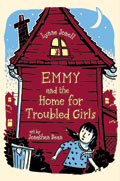
At the start of this book, Emmy really wants to make friends with girls her own age. Most of the emotional arc of this book follows her punishment for this horribly selfish desire, until she repents and saves everyone and her former friends (and even one human girl!) reluctantly let her back into their good graces. This is a bit of an exaggeration, and I suspect that any kid who read this book would not recognize it from that description, but I kept wanting to reach into the book and tell Emmy that it was OK to still hurt after the abuse of the previous year, and that if the creatures around her didn't support that then they weren't good friends. Instead, Emmy hesitates to intervene when an annoying (but saintly) rat accosts her while Emmy is attempting to talk to some classmates, resulting in an injury to the clueless rat that Emmy blames herself for . All her old friends, rat and human, now hate her for letting the rat get hurt, while I blamed the author for setting up the poor girl.
In between this there is lots of good adventure, people turning into rats, people living in dollhouses, six year olds clobbering soccer balls, and other good stuff. I suspect my fourth graders would enjoy it a lot, but my biggest impression was the red light indicated moral failure when Emmy preferred trying to make friends for the first time in over a year to hanging out with the rats who helped defeat the evil nanny. The patterns of children's literature all screamed that this was the tragic flaw that would lead Emmy into her great fall, but only gross authorial shenanigans wrangles any harm from "weakness." Humph.
On the plus side, the authors name starts with a "J".
No comments:
Post a Comment